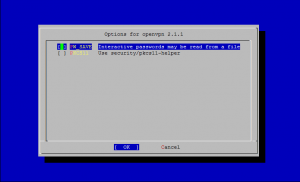FreeBSD: System Monitoring with MRTG
The Multi Router Traffic Grapher, or just simply MRTG, is free software for monitoring and measuring the traffic load on network links. It allows the user to see traffic load on a network over time in graphical form.
1. Installing Apache2 HTTP Server
Install Apache on the server you wish to display MRTG stats from:
cd /usr/ports/www/apache22 make install clean
To run Apache2 at system startup, append the following line to /etc/rc.conf :
apache22_enable="YES"
Start Apache2, enter:
/usr/local/etc/rc.d/apache22 start
 Print This Post
Print This Post
OpenBSD: How To Create a Transparent Bridge
A network bridge is a device which connects two parts of a network together. In this article I'll show you how to create a transparent bridge in OpenBSD.
To activate the bridge in OpenBSD run the following commands:
echo up > /etc/hostname.xl0 echo up > /etc/hostname.xl1 echo add xl0 add xl1 up > /etc/bridgename.bridge0
This will setup the two interfaces (xl0 and xl1) and add them into the bridge0.
Now, you need to enable IP forwarding so that IP packets will pass from one interface to another.
To enable ip forwarding add the following line to /etc/sysctl.conf:
net.inet.ip.forwarding=1
Once this is all done, reboot to activate.
reboot
 Print This Post
Print This Post
OpenBSD: How To Install OpenBSD Ports and Packages Collection
OpenBSD is a fairly complete system of its own, but still there is a lot of software that one might want to see added.
The port collection, originally borrowed from FreeBSD and significantly rewritten, fills this gap. The concept is to have, for each third-party software, a Makefile that controls:
- where to fetch it,
- how to do the fetch,
- what it depends upon (if anything),
- how to alter the sources (if needed),
- how to configure, build and install it.
This information is kept in a directory hierarchy under the /usr/ports directory.
Packages are the binary equivalent of ports. A compiled port becomes a package that can be easily installed and registered into the system using pkg_add utility.
 Print This Post
Print This Post
OpenBSD: How To Install OpenBSD – OpenBSD 4.7 Installation Guide
OpenBSD is a Unix-like operating system descended from Berkeley Software Distribution (BSD), a Unix derivative developed at the University of California, Berkeley.
The OpenBSD project produces a FREE, multi-platform 4.4BSD-based UNIX-like operating system. OpenBSD supports binary emulation of most programs from SVR4 (Solaris), FreeBSD, Linux, BSD/OS, SunOS and HP-UX.
This article is a step-by-step guide about how to install OpenBSD 4.7 using the installation CD. The installation guide will show a clean install, meaning any operating system or information already on the computer will be erased.
 Print This Post
Print This Post
How To Install and Configure ddclient in FreeBSD and Linux to work with OpenDNS
ddclient is an open-source dynamic IP update client written in Perl. ddclient is available here.
This article shows how to install and configure ddclient in FreeBSD and Linux so it will update your OpenDNS account with your dynamic IP from your ISP.
1. Installation
For CentOS / Fedora, install ddclient via yum:
yum install ddclient
For Debian and Ubuntu, install ddclient via apt-get:
apt-get install ddclient
For FreeBSD, install ddclient from the FreeBSD ports collection:
cd /usr/ports/dns/ddclient make install clean
2. Configuration
After installing ddclient, you have to create / edit ddclient.conf ( for FreeBSD the configuration should be located in /usr/local/etc, for CentOS should be located in /etc/ddclient and for Debian or Ubuntu in /etc ) as follows:
 Print This Post
Print This Post
How To Install OpenVPN in FreeBSD
OpenVPN is a an open source software application that implements virtual private network (VPN) solutions for creating secure point-to-point or site-to-site connections in routed or bridged configurations and remote access facilities. OpenVPN uses SSL/TLS security for encryption and is capable of traversing network address translators and firewalls.
I. OpenVPN Server - Installation and Configuration
1. Installing OpenVPN Server
To install OpenVPN from FreeBSD ports, enter:
cd /usr/ports/security/openvpn make install clean
 Print This Post
Print This Post
How To Update CentOS Linux 5.4 to CentOS 5.5
CentOS ( Community ENTerprise Operating System ) is a community-supported, mainly free software operating system based on Red Hat Enterprise Linux. It exists to provide a free enterprise class computing platform and strives to maintain 100% binary compatibility with its upstream distribution.
CentOS 5.5 has been released and available via mirrors for immediate update. For more information about this release you can read the release note.
If you have CentOS 5.4 already installed, before to do anything first back up anything you care about.
 Print This Post
Print This Post
How To Install Lighttpd with PHP5 and MySQL support on CentOS 5
Lighttpd is an open-source web server optimized for speed-critical environments. It's standards-compliant, secure and flexible. In this tutorial I'll show you how to install Lighttpd on a CentOS 5.4 server with PHP5 support (through FastCGI) and MySQL support.
1. Installing MySQL 5 Server
To install MySQL run this command from the shell:
# yum install mysql mysql-server
Enable MySQL server on boot and start MySQL server:
# chkconfig --levels 235 mysqld on
# service mysqld start
 Print This Post
Print This Post
How To Limit CPU Usage of A Process with cpulimit under Linux
In this tutorial I'll show you how you can limit the CPU usage of a process with cpulimit tool on Debian/Ubuntu Linux.
cpulimit is a program that limit the CPU Usage of a process (expressed in percentage, not in CPU Time). This is very useful to control batch jobs, when you don't want them to use to much CPU. cpulimit is able to adapt itself to the overall system load, dynamically and quickly.
 Print This Post
Print This Post
